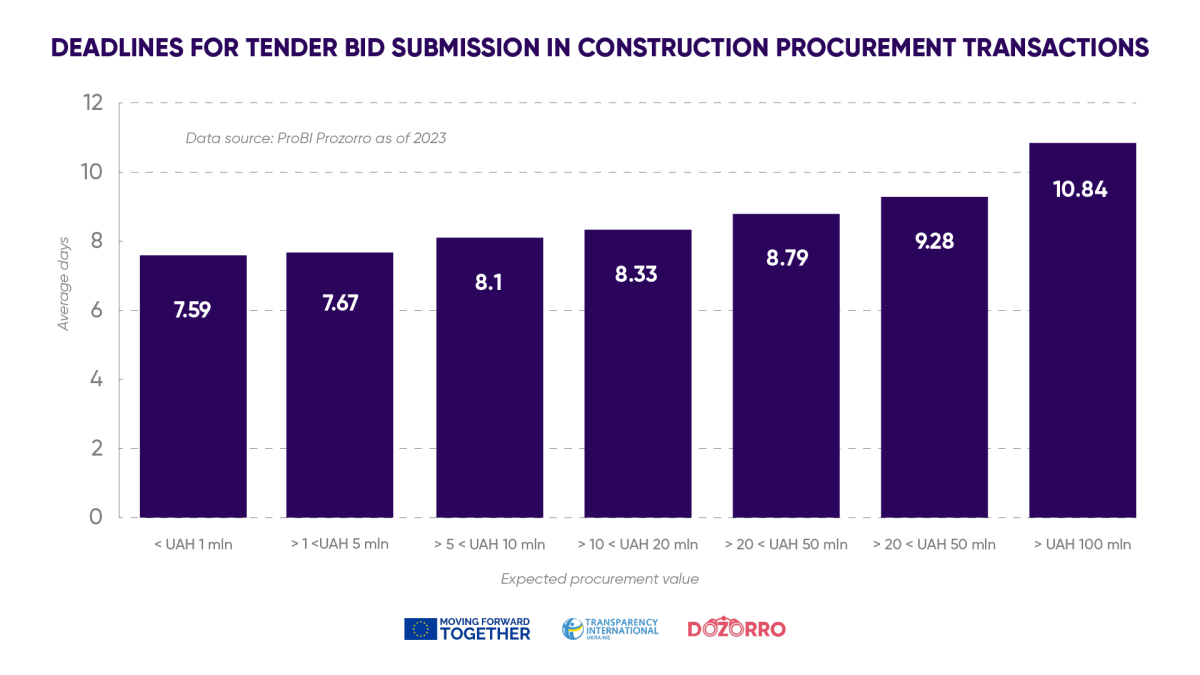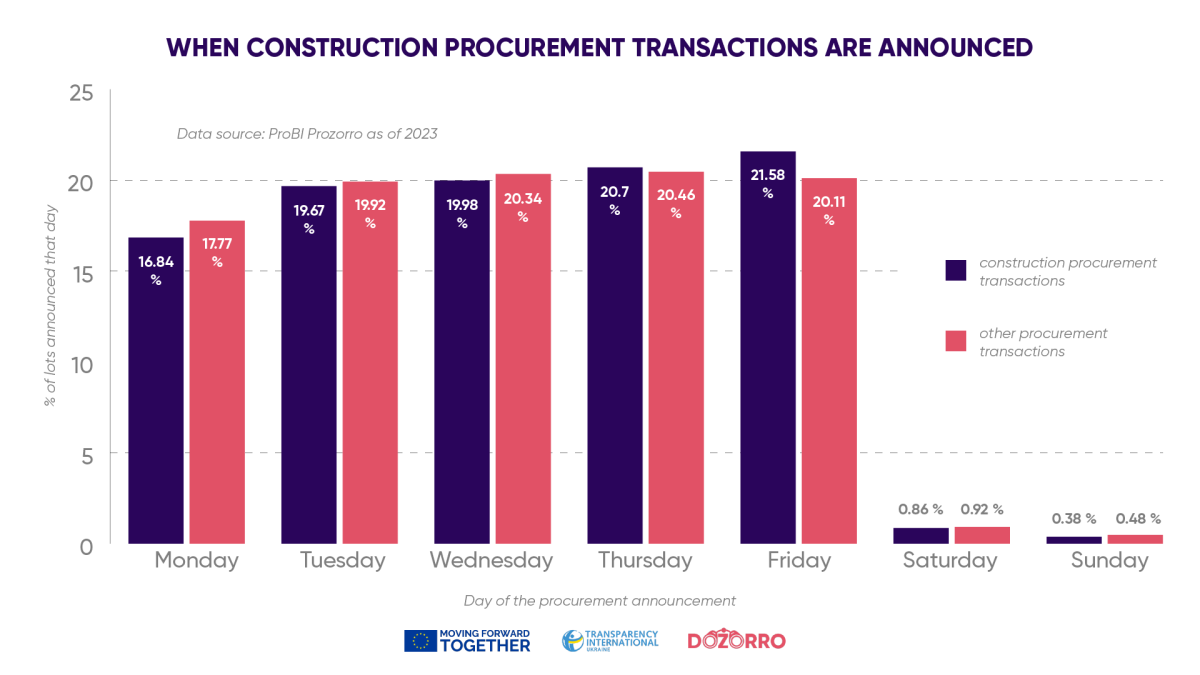

Currently, the main competitive procedure in public procurement is open bidding with features. The deadline for related tenders cannot be less than seven days from the day the announcement on open bidding in the electronic procurement system is posted (cl. 34, Features). If the procuring entity introduces changes to the tender documentation, the deadline for bid submission should be extended so that the participants have at least four days (cl. 54, Features).
Establishing a minimum deadline for tender bids submission in complex procurement transactions can be viewed as a way to limit the range of future participants. This specifically applies to construction works, when estimate documents require a lot of time to be prepared. On the other hand, participants who are aware of the future procurement in advance and have tender documentation may prepare their bidding files earlier and even submit these within the minimum deadline. Moreover, the minimum deadline for tender bid submission complicates the appealing procedure against procurement terms and conditions. A complaint can be filed at the stage of bid submission, after announcing the procurement, while the same opportunity disappears 3 days before the stage ends.
So, we decided to evaluate ways procuring entities set their deadlines for bid submission nowadays, and their impact on the number of participants in construction tenders.
Data selection
For the purposes of the study, we limited procurement to the following CPV classes:
- 45400000-1 Finishing construction works
- 45200000-9 Works related to completed or non-complete construction assets and civil facilities
- 45300000-0 Construction and installation works
- 45100000-8 Construction site preparation
Other selection limitations:
- Year the procurement transaction was announced — 2023.
- Lot status — completed, active, canceled, unsuccessful.
- Type of procurement method — open bidding with features.
- A number of participants in lots is known.
- All procurement transactions where the procuring entity introduced changes to the tender documentation (21% of the total number) were excluded as the analysis did not include an assessment of these changes’ significance. Therefore, we cannot understand their impact on the tender bid preparation: whether all documents should be designed from scratch or no changes should be made to the tender bid documents.
- Abnormal indicators were also excluded. This covers procurement where the deadline for bid submission was met in less than 5 lots. Such procurement transactions distort the statistics, particularly the average values, so we removed them from the selection.
The more complex the project, the more time it takes to make the necessary calculations, an estimate, and prepare a tender bid in general. There are no clear indicators to categorize the said works by complexity, so we used the expected value.
We assumed that the complexity of construction works (the construction assets themselves) would increase in line with the expected procurement value. For 91% of procurement transactions included in our selection, the said value does not exceed UAH 10 million. So we analyzed this range in more detail by dividing it into three groups:
- up to UAH 1 million We have analyzed the items purchased for the said amounts — in this period, the procurement item is mostly simple construction works (insulation of the building facade, replacement of windows, installation of new sanitary ware in toilets, block paving, etc.). The volume of such works is insignificant, and the contractor may perform them in a fairly short period (up to 1–3 weeks). For such procurement transactions, tender bids do not require a lot of time to be prepared (minimum estimate documents), and the contractor does not have to involve complex construction machinery and equipment to perform works/services (cranes, bulldozers, loaders, etc.).
- UAH 1 – 5 million More complex construction works: roofing works, repairs of minor facilities.
- UAH 5 – 10 million In this group, construction assets are characterized by increased complexity, and the execution of work requires certain specific construction machinery (cranes, bulldozers, loaders, etc.) and qualified engineers.
The following ranges of expected values are grouped under the similar assumption that the complexity increases in line with the expected value and the scope of work performed.
So, we defined the following groups:
- EV (expected value) < UAH 1 million;
- 1 <= EV < UAH 5 million;
- 5 <= EV < UAH 10 million;
- 10 <= CA < UAH 20 million;
- 20 <= EV < UAH 50 million;
- 50 <= EV < UAH 100 million;
- EV > UAH 100 million.
The final selection included 24,514 lots.
Data analysis and hypothesis testing
For 75% of the lots from our selection (18,500), the deadline for tender bid submission was minimal — 7 calendar days. For another 9% of the lots (2,322), the deadline for tender bid submission was 8 days, and for 7% of the lots (1,827) — 9 days.
Hypothesis 1.
The deadline for tender bid submission increases in line with the expected value.
________________________________________
Since expensive construction orders are potentially more complex, we have assumed that participants will be given more time to prepare their bidding documents. There is such a general trend though it is quite subtle. There is a slight increase in the deadline for tender bid submission depending on the expected value — from an average of 7.59 days for procurement transactions in the group of up to UAH 1 million to an average of 9 days for procurement transactions with EV ranging UAH 50-100 million.
The hypothesis is partially confirmed.
Hypothesis 2.
Procuring entities announce procurement transactions on Friday during late business hours and set a minimum deadline for bid submission or even on weekends (Saturday, Sunday) to reduce the time for tender bid submission by undesirable suppliers.
________________________________________
Usually, both businesses and procuring entities operate a five-day work week, Monday to Friday. Therefore, if the procurement is announced on Friday during late business hours, participants will probably see it on Monday. Therefore, the time to prepare bids will be even shorter. We have checked the frequency of such situations.
From Monday to Friday, the number of procurement transactions increases. Procuring entities announced the most lots on Friday — 5,289 lots or 21.6%. 57.3% of these were announced after lunch, that is, after 2:00 p.m.
1.2% of the total number of lots was announced on the weekend. Total on Friday–Sunday — 22.8%.
23.8% of the lots with other CPV codes were announced on Friday–Sunday. 52.2% of the lots of all Friday procurement transactions were announced after 2:00 p.m.
For construction procurement transactions, almost the same share of lots is announced on the last days of the week as for other CPVs.
For 58.4% of construction procurement transactions announced on Friday, Saturday, and Sunday, the deadline for bid submission was minimal. No one applied for every eighth of them, and there was only 1 supplier for almost two-thirds of the lots. In general, this falls under the average indicators for construction procurement. So, we cannot conclude that the day of the announcement affects the number of participants.
If we compare activity on procurement with the minimum deadline for bid submission announced on different days, the numbers will be almost the same:
- 0 participants — 12.2% of the Friday–Sunday lots versus 11.9% of the Monday–Thursday lots
- 1 participant — 61.1% of the Friday–Sunday lots versus 62.7% of the Monday–Thursday lots
To sum up, procuring entities declare lots for construction procurement in almost the same days as for procurement with other CPV codes. There is also no significant difference in the number of participants for lots started on Friday–Sunday.
The hypothesis is rejected. At the same time, it should be noted that some procuring entities tend to announce construction procurement on Friday after 2:00 p.m.
Hypothesis 3.
If the number of days given for bid submission increases, so does the bidding competition.
________________________________________
In the procurement transactions studied, the bidding competition increases in line with the deadline for tender bid submission. The average competition level is 1.32 participants.
The average number of participants depending on the 7–10 day-long deadline for tender bid submission:
- 7–10 days — 1.39 participants
- 11–15 days — 1.51 participants
- 16–20 days — 1.78 participants
- 21–25 days — 1.71 participants
- 26–40 days — 1.86 participants
The hypothesis is confirmed.
Hypothesis 4.
The increase in the deadline for bid submission results in a decrease in the number of lots where procuring entities apply the 24-hour term to correct discrepancies and disqualify participants, as well as in lots with 0–1 participant.
________________________________________
We assumed that the short deadline for tender bid submission prevents businesses from preparing documents in a quality manner. Therefore, they either submit a tender bid with discrepancies or do not enter the bidding. So, we have analyzed whether the following events are more common in procurement with a short deadline for bid submission:
- 0 participants
- disqualification
- 24 hours to correct discrepancies
This hypothesis is not confirmed. Where the deadline for bid submission was 7 days, there were 34.9% of lots featuring the following: a demand to eliminate inconsistencies, and/or no participant applied for the procurement, and/or the procuring entity rejected one tender bid. Where the deadline for bid submission was 8 days, there were already 34.4% of such lots, for 9 days — 34.9%, 10 days — 32.4%, and 11 days — 37.1%.
The hypothesis is rejected.
We have also analyzed whether the share of procurement transactions with discrepancies and 24 hours was different for procurement transactions with more than 1 participant:
| Construction (no lots with TD changes) |
Construction (including lots with changes introduced to the TD) | Other CPV codes without lots with TD changes | Other CPV codes including lots with changes introduced to the TD
|
|
| 24 hours | 33.49% | 33.59% | 34.49% | 35.65% |
| Disqualification | 36.92% | 38.56% | 30.12% | 31.12% |
We did not include procurement transactions with only 1 participant assuming that in such a case the procuring entity would not be intending to give 24 hours to eliminate discrepancies and would recognize the participant as the winner at once, turning a blind eye to minor errors to complete the procurement.
In general, for construction procurement transactions with more than 1 participant, procuring entities apply the 24-hour mechanism to eliminate discrepancies just as they do for other procurement items. Though participants in construction procurement are disqualified a bit more often.
Conclusions
For 75% of the lots, procuring entities set a minimum deadline for bid submission. Generally, the said term increases slightly in line with the expected value of the lot, but not significantly: on average, from 7.7 days for procurement with EV of up to UAH 1 million to 9.6 days for procurement with EV ranging UAH 50-100 million.
At the same time, lots with a longer deadline for submission attract more participants on average: 1.39 participants for 7–10 days, 1.78 participants for 16–20 days, and 1.86 participants for 26–40 days. In general, this trend is observed in different groups of expected value.
Obviously, the deadline is not the only factor affecting competition in procurement. Procuring entities providing businesses with more time to prepare documents can also make other procurement elements more convenient for participants, for example, setting more transparent and clear requirements in TD.
However, extending the deadline for bid submission will give businesses more time to detect deficiencies in TD, send a question or demand to the procuring entity, or file a complaint to the AMCU in case of discriminatory terms and conditions.
Therefore, we believe that it is expedient to consider increasing the minimum deadline for bid submission in case of construction procurement — for example, up to 15 days, as it is set in the Law on Public Procurement. To determine the relevant deadline, the said change should also be discussed with the business.
We sent the outcomes of this analysis to the Ministry of Economy for review. We believe they will help make construction procurement more competitive and efficient.
This publication was prepared with the financial support of the European Union. Its content is the sole responsibility of Transparency International Ukraine and does not necessarily reflect the views of the European Union.










